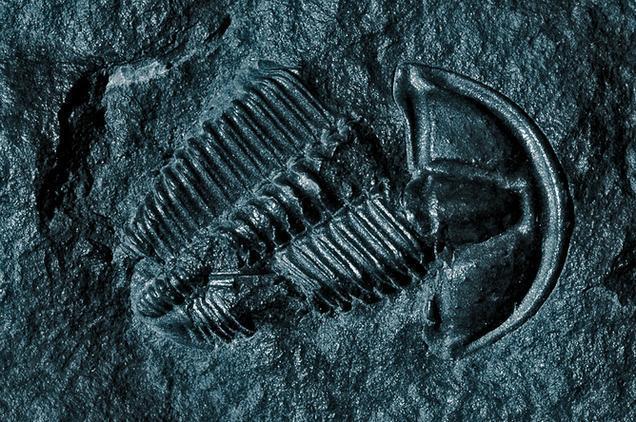April 1, 2014
LONDON: The biggest mass extinction in the history of the world which killed off more than 90 per cent of all living species happened because of an act of microbial sex that caused a suffocating release of methane and carbon dioxide, a study has found.

April 1, 2014
LONDON: The biggest mass extinction in the history of the world which killed off more than 90 per cent of all living species happened because of an act of microbial sex that caused a suffocating release of methane and carbon dioxide, a study has found.

A fossil of a trilobite, a horsecrab-like creature that thrived in the seas for hundreds of millions of years before becoming one of many kinds of animals wiped out in a mass extinction that befell the planet 252 million years ago. (University of Chicago handout)
The mass extinction — known as The Great Dying — occurred at the end of the Permian period some 252 million years ago and was by far the worst of the five mass extinctions on Earth in terms of the broad array of marine and terrestrial creatures that it killed off.
Scientists had previously proposed a variety of possible causes ranging from huge volcanic eruptions and global climate change to a cataclysmic asteroid impact, but none was totally satisfactory in explaining this uniquely terrible crisis in the history of life on Earth.
Now, however, a team of American and Chinese scientists has found evidence to suggest that the real trigger for the abrupt disappearance of virtually all forms of life at the time was the promiscuous passing of genetic material between two species of microbes in a form of sex.
They believe that the sudden acquisition of a new set of genes enabled methane-producing microbes to feed off the abundant deposits of organic carbon that had built up in the oceans at that time. This led to an explosive growth in these Methanosarcina microbes and an equally explosive release of their waste gases, which suffocated almost all other life-forms on land and in sea.
"This would have made a very traumatic time in the history of life far worse. It could have been the killer blow that led to the biggest mass extinction we've known," said Greg Fournier of the Massachusetts Institute of Technology (MIT) in Cambridge, Massachusetts.
Methane and carbon dioxide are both powerful greenhouse gases but they also dissolve easily in water and their sudden, exponential build-up in the oceans would have caused oxygen starvation and high levels of acidity — a lethal "double whammy" for the many shelled marine organisms alive at the time.
The extinction at the end of the Permian period, which marked the beginning of the Triassic period, was unusual even by the standards of the other four great mass extinctions. The Great Dying killed off all but about four per cent of marine species, exterminated 70 per cent of terrestrial vertebrates, and was the only mass extinction to have seriously affected insects -natural-born survivors that lived through the rise and fall of the dinosaurs and other dramatic periods of mass extinction.
The MIT scientists, working with colleagues from the Chinese Academy of Sciences, carried out a genetic analysis on about 50 different genomes of methane-producing bacteria and found that they must have acquired the ability to "eat" dissolved organic carbon around 252 million years ago — coinciding with the known time of the Permian mass extinction.
They suggest that this sudden ability was acquired with a set of genes inherited from a cellulose-degrading bacterium and aided by abundant amounts of nickel — a biochemical catalyst — deposited in the oceans at the time from the huge eruptions of supervolcanoes in Siberia.
Dr Fournier, one of the authors of the study published in the journal Proceedings of the National Academy of Sciences, said that this would explain the exponential rise of carbon dioxide and methane with the exponential increase in the population of methane-producing microbes.
"A rapid initial injection of carbon dioxide from a volcano would be followed by a gradual decrease. Instead, we see the opposite — a rapid, continuing increase," Dr Fournier said.
"That suggests a microbial expansion. The growth of microbial populations is among the few phenomena capable to increasing carbon production exponentially," he said.
An analysis of sediments in China from ancient oceans shows that nickel build-up also happened at about the same time, following the Siberian eruptions, which would have allowed the accelerated release of carbon dioxide and methane — choking most marine life-forms that survived the rising acidity as well as causing global warming and extreme climate change.
The rate at which carbon dioxide would have been released was on a par with the modern emissions caused by the burning of fossil fuels, but they would have gone on for several thousand years. This could have triggered the release of poisonous hydrogen sulphide gas which would have added to the stress of land animals, said Professor Dan Rothman of MIT, the lead author of the research.
"The cumulative impact of all these things is much more powerful than any one individually. No one thing on its own is convincing, but the totality of it all can explain it," said Professor Rothman.
A crucial piece of evidence came from an analysis of carbon isotopes found in sediments dating back to this time period. These indicated a major increase in carbon dioxide which continued to rise exponentially as a result of the breakdown of methane released as a waste product by the Methanosarcina microbes, he said.
"There was some kind of instability in the carbon cycle that went up exponentially, which we were unable to reconcile with existing theories about volcanoes being the cause of the mass extinction at the end of the Permian," Professor Rothman added.
"A lot of this rests on the carbon isotope analysis, which is strong and clear. If it wasn't such an unusual signal, it would be harder to eliminate other possibilities," he said.
However, it may take further evidence to convince other scientists that it was a genetic innovation in a microscopic organism that ultimately triggered the biggest biological crisis in the history of life on earth.
The Big Five: A short history of mass extinctions
- Ordovician-Silurian (443m years ago): most of life lived in the seas. About 85 per cent of marine species were killed, mostly at two peak dying times separated by hundreds of thousands of years.
- Late Devonian (359m years ago): about three quarters of species went extinct over a period of several million years. Much of the sea became starved of oxygen, possibly due to asteroid impacts.
- Permian (252 million years ago): nicknamed the Great Dying because it was the biggest mass extinction in history, killing off about 96 per cent of marine species. Volcanoes were thought to be involved.
- Triassic-Jurassic (200m years ago): occurred over several million years at the end of the Triassic. About half of all species at the time disappeared, but strangely plants were not badly affected.
- Cretaceous-Tertiary (65m years ago): famous for being the death knell of the dinosaurs. A giant asteroid impact was almost certainly involved, possibly preceded by a long period of volcanic eruptions.
Courtesy: The Independent
















































































































